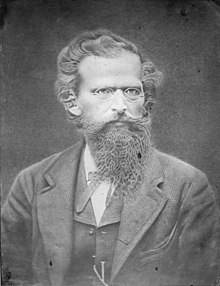Helge Palmcrantz
Helge Palmcrantz | |
|---|---|
 | |
| Born | Carl Helge Julius Palmcrantz July 7, 1842 |
| Died | November 22, 1880 (aged 38) |
| Nationality | |
| Occupation | Inventor, Firearms designer |
| Spouse(s) | Susanna Josephina Winborg |
Helge Palmcrantz (July 7, 1842–November 22, 1880) was a Swedish inventor and industrialist. [1]
Biography[]
Palmcrantz was born at Hammerdal in Jämtland, Sweden. He was the son of Per Gustaf Palmcrantz (1806–1905) and Lovisa Ulrika Nordenmark His father was a captain in the Jämtland Ranger Regiment. He was enlisted as a cadet in his father's regiment, where he worked on land survey. After a couple of years he left the regiment to study at the Technological Institute of Stockholm, later known as KTH Royal Institute of Technology.
In partnership with his brother-in-law, Theodor Winborg (1832-1918), Palmcrantz founded a small workshop on Vollmar Yxkullsgatan 25, Södermalm, Stockholm. As number of employees increased along with the production volume, he moved to a new factory on Kungsholmen, Stockholm, where they manufactured firearms, reaping machines, mowers and other agricultural equipment of their own design.[2] Later on there would be Palmcrantz factory, Palmcrantzska Fabriken, on Lövholmen, Stockholm.[3] [4]
In 1868, the first version of his machine-gun was finished and a demonstration of its capacity was held on Ladugårdsgärdet, Stockholm in front of the Swedish Defense Minister; G.R. Abel. After a couple of modifications and improvements, he patented the multi-barrel, lever-actuated, machine gun and it was bought into the Swedish army. Same year, the machine-gun was shown on the 1873 Vienna World's Fair.
To reach international success, Palmcrantz met industrialist Thorsten Nordenfelt (1842-1920) in 1875 and the latter's company became his British agent. They agreed to market the machine-gun under the then well known Nordenfelt brand and his second model would later be known as the Nordenfelt machine-gun after his financial backer. It was Nordenfelt who convinced Palmcrantz to increase the caliber of his gun to one inch, making it a suitable weapon for use against the growing threat of torpedo boats.[5]
Palmcrantz succumbed to an early death from a bleeding ulcer. He was buried at Norra Begravningsplatsen in Stockholm.
Helge Palmcrantz has a former school named after him; Palmcrantzskolan in Östersund. The block names "Kulsprutan" and "Lavetten" on Kungsholmen is named after his factories at Hantverkargatan.
References[]
- ^ "C Helge J Palmcrantz". Svenskt biografiskt lexikon. Retrieved May 1, 2020.
- ^ "patent 2309". The Commissioners of patents' journal. Great Britain. Patent Office. 1876. p. 2153.
- ^ "Aktiebolaget Palmcrantz & C:o". Sveriges industri - dess stormän och befrämjare. Retrieved May 1, 2020.
- ^ "Carl Helge Julius Palmcrantz". Technical Museum. Retrieved May 1, 2020.
- ^ Smith, Anthony (2004). Machine Gun: The Story of the Men and the Weapon That Changed the Face of War. Macmillan. p. 69. ISBN 978-0-312-93477-4.
External links[]
| Wikimedia Commons has media related to Helge Palmcrantz. |
- 1842 births
- 1880 deaths
- People from Jämtland
- 19th-century Swedish inventors
- Weapon designers
- Firearm designers
- 19th-century Swedish businesspeople
- Swedish nobility
- KTH Royal Institute of Technology alumni